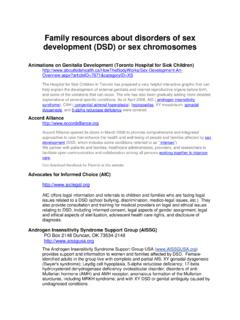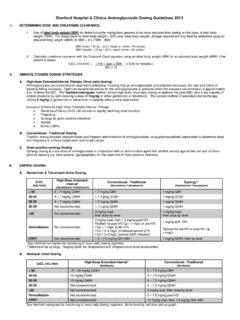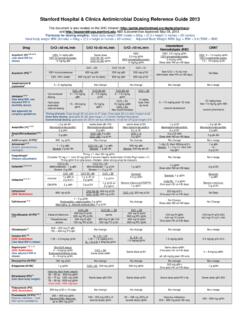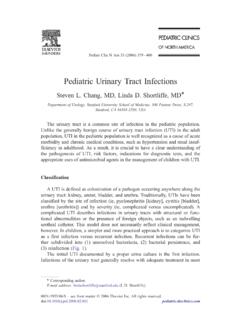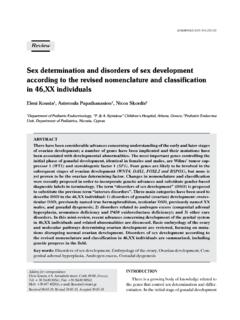Transcription of Genital Surgery for Disorders of Sex Development ...
1 Freund Publishing House Ltd., London Journal of Pediatric Endocrinology & Metabolism, 23, 789-806 (2010) VOLUME 23, NO. 3, 2010 1 Genital Surgery for Disorders of Sex Development : Implementing a Shared Decision-Making Approach Katrina Karkazis1, Anne Tamar-Mattis2 and Alexander A. Kon3 1 Center for Biomedical Ethics, Stanford University, Palo Alto 2 Advocates for Informed Choice, Cotati,3 Department of Pediatrics and the Program in Bioethics at the University of California Davis, Sacramento, CA, USA ABSTRACT Ongoing controversy surrounds early Genital Surgery for children with Disorders of sex Development , making decisions about these procedures extraordinarily complex.
2 Professional organizations have encouraged healthcare pro-viders to adopt shared decision-making due to its broad potential to improve the decision-making process, perhaps most so when data are lacking, when there is no clear best-choice treatment, when decisions involve more than one choice, where each choice has both advantages and disadvantages, and where the ranking of options depends heavily on the decision-maker s values. We present a 6-step model for shared decision-making in decisions about Genital Surgery for Disorders of sex Development : 1) Set the stage and develop an appropriate team; 2) Establish preferences for information and roles in decision-making; 3) Perceive and address emotions; 4) Define concerns and values; 5) Identify options and present evidence; and 6) Share responsibility for making a decision.
3 As long as controversy persists regarding Surgery for DSD, an SDM process can facilitate the increased sharing of relevant information essential for making important health care decisions. KEY WORDS (MeSH): decision-making; sex differentiation Disorders ; Hermaphroditism; urogenital surgical procedures Corresponding author: Katrina Karkazis, PhD, MPH ABBREVIATIONS CAH Congenital adrenal hyperplasia DSD Disorders of sex Development RCT Randomized controlled trial SDM Shared decision-making INTRODUCTION Disorders of sex Development (DSD) is an umbrella term adopted to refer to the host of congenital conditions in which Development of chromosomal, gonadal, or anatomical sex is atypical 1.
4 For those DSD characterized by atypical Genital appearance, standard practice since the 1950s has been to perform Surgery intended to modify the infant s genitals to make them more typical for the sex of rearing to facilitate gender identity development2-5. For more than a decade, however, there has been intense debate both within and outside medicine regarding the timing, necessity, benefits, and risks of elective Genital Surgery for children born with DSD6. (There is no dispute about the necessity of operations to address imminent threats to the infant s health, such as the creation of a urinary opening.)
5 Decisions about genitoplasty are made challenging by the dearth of clinical evidence regarding long-term psychological and physical outcomes1,6. Because evidence is lacking (and existing evidence is contested)1,7, providers make treatment recommendations based in large part on their personal values, anecdotal evidence, and gut feeling 13-16. Some providers further report feeling unsure about the right decision in such cases8. Meanwhile, some parents express dis-satisfaction with the information they receive 2 K.
6 KARKAZIS ET AL JOURNAL OF PEDIATRIC ENDOCRINOLOGY & METABOLISM about surgical options, report feeling rushed into a decision, and express decisional regret8. Taken together, these circumstances make decisions about Genital Surgery extraordinarily complex. In recent years, organizations such as the Institute of Medicine, the Agency for Healthcare Research and Quality, the American College of Physicians, the American Academy of Family Physicians, the Society of Critical Care Medicine, and the American Urological Association have encouraged doctors to adopt a shared decision-making (SDM) approach when complex or difficult decisions must be made regarding interventions or appropriate goals of care17-23.
7 SDM is an important tool for making health care decisions and this is perhaps most so when data are lacking, when there is no clear best-choice treatment, when decisions involve more than one choice, where each choice has both advantages and disadvantages, and where the ranking of options depends heavily on the decision-maker s values9,10. Despite SDM s promise, the lack of specific models outlining how to implement SDM in particular contexts has meant its adoption has been uneven10. In this paper, we present a 6-step model for the application of SDM in decisions about Genital Surgery for children born with DSD.
8 Although SDM cannot provide a right answer in such difficult situations, an SDM process can facilitate the increased sharing of relevant information essential for making important health care decisions. SDM gives providers the opportunity to clarify the basis for their recommendations, identify and fill gaps in parents understanding about the diagnosis and treatment options, and explore the values underlying both parents and clinicians concerns. The process of thoroughly examining alternatives and the encouragement of transparency and questioning involved in SDM can help to ensure that the best interests of the child and family are served, patient care and the doctor-patient relationship are improved, satis-faction with the decision-making process is increased for both physician and parents, deci-sional conflict and regret are minimized, and ethical and legal requirements for informed permission (and assent when appropriate) are met.
9 WHAT IS SHARED DECISION-MAKING? SDM is an evolving concept, but generally centers on the collaboration of patients and caregivers in making difficult healthcare choices allowing them jointly to bear the burden and responsibility of decision-making9,11-14. SDM differs in several key ways from other widely cited approaches to medical decision-making such as the paternalistic model and the autonomy-driven (or informed) model. In the paternalistic model, the physician is understood as best suited to determine the patient s best interest and hence the patient is given limited information and a passive role in the treatment decision-making process largely limited to providing consent for the treatment the physician This model was dominant in the United States through the 1960s and remains the standard in many parts of the The autonomy-driven (or informed)
10 Decision-making model places the authority to decide squarely on the patient herself, and under such a model the physician primarily provides the patient with information about her medical condition and treatment options. In the autonomy-driven model, which has become the standard in the United States15, the physician s role is largely one of information sharing11. This model, however, ignores data showing that most patients prefer a shared decision-making process, and thus autonomy-driven decision-making often leaves patients (and presumably parents) feeling abandoned by the physician16-20.
